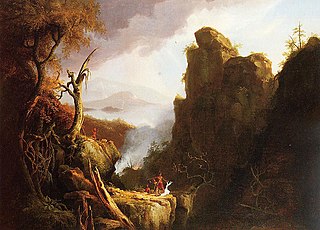 W
WThe Abduction of Rebecca is a mid-19th century painting by French artist Eugène Delacroix. Done in oil on canvas, the work depicts the a scene from Sir Walter Scott's novel Ivanhoe in which the heroine Rebecca is abducted. Delacroix produced the painting during the height of the French Romanticist Movement, and presented the work at the Paris Salon of 1846. The 1846 version of Abduction is currently in the collection of the Metropolitan Museum of Art, which describes the work as "one of Delacroix’s greatest paintings". in 1858 Delacroix created an almost identical work for the Paris Salon of 1859; the second version of Abduction is in the collection of the Louvre.
 W
WArch of Nero is an 1846 oil on canvas painting by Thomas Cole. It is currently on display at the The Newark Museum of Art.
 W
WThe Cock Fight is an 1846 painting by the French artist Jean-Léon Gérôme. It is also known as Young Greeks Attending a Cock Fight. It is an example of the Neo-Grec style. It was one of Gérôme's first successes.
 W
WThe Examination of Savonarola is an 1846 oil on canvas painting by the French history painter François Marius Granet, showing the trial of Savonarola. It is now in the Musée des Beaux-Arts de Lyon.
 W
WThe Forest in Winter at Sunset is a mid-19th century oil painting by Théodore Rousseau. The painting, which depicts a forested landscape in wintertime, is currently on display at the Metropolitan Museum of Art.
 W
WMusidora: The Bather 'At the Doubtful Breeze Alarmed', also known as The Bather, is a name given to four nearly identical oil paintings on canvas by English artist William Etty. The paintings illustrate a scene from James Thomson's 1727 poem Summer in which a young man accidentally sees a young woman bathing naked, and is torn between his desire to look and his knowledge that he ought to look away. The scene was popular with English artists as it was one of the few legitimate pretexts to paint nudes at a time when the display and distribution of nude imagery was suppressed.
 W
WPortrait of the Sculptor Jens Adolf Jerichau, the Artist's Husband is a portrait of the Danish sculptor Jens Adolf Jerichau painted in 1846 by Elisabeth Jerichau-Baumann, the same year they married.
 W
WRoman Campagna, also called Ruins of Aqueducts in the Campagna Di Roma is an 1843 oil on canvas painting by Thomas Cole. It is currently displayed at the Wadsworth Atheneum in Connecticut.
 W
WThe Sicilian Vespers is the title of three works by the Italian artist Francesco Hayez, all showing the outbreak of the Sicilian Vespers.
 W
WThe Flower Girl is a mid 19th-century painting by Irish-American artist Charles Cromwell Ingham. Done in oil on canvas, the painting depicts a young woman holding a bouquet of flowers. The painting is currently in the collection of the Metropolitan Museum of Art.
 W
WThe Last of the Mohicans: The Death of Cora, also known as Indian Sacrifice, is a c. 1827 painting by British-American painter Thomas Cole, the founder of the Hudson River School. The painting depicts the death of Cora from the 1826 American novel The Last of the Mohicans. It is one of four such paintings by Cole which depict scenes from the novel. The painting is currently owned by the University of Pennsylvania.